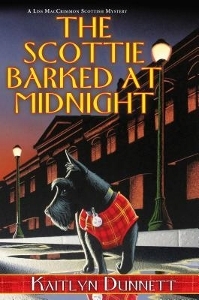Kathy Lynn Emerson's Blog, page 90
November 17, 2015
Where Are The Perks?
by Dorothy Cannell
I am feeling embittered. My life as a published author has little similarity to the glamorous, pampered existence I once believed would be assured me in return for the gift of my every printed word.
Where is the devotedly efficient housekeeper? As I write this the dust thickens on furniture and in corners and will continue doing so until I hear my husband stomping around muttering that when it comes to cleaning a man’s work is never done. Where are the secretaries? The clerical one who would proof read this blog when finished, correcting punctuation and deleting as she (or he) deems required. The social one who would this afternoon take our two cats to the vet for their check ups. Then go and have my hair cut for me. Where is the French chef ready whip up elegantly delicious meals, snacks, drinks at a moment’s notice? Instead, previously mentioned husband (name escapes me) is putting a hot dog and baked bean casserole in the not preheated oven.
This mood will pass. I will see the negatives of having a home cluttered with staff. I’d have to talk to them for one thing – time consuming. I’d have to accept despising looks – if my hair wasn’t well combed or I slobbed around in my dressing gown all day.
There is a positive side to this pettishness regarding reality. It springs from having reached a point in current book Peril in the Parish where I want to burrow in and not come out until my characters pause in telling me what comes next. Against this there is the tug of the real world, because though less exciting than the fictional one (Scotland Yard has never requested my help in solving a particularly difficult case) it provides the base for who I am as a person and a writer.
I am now going to try and sort out what our two cats are arguing about – hopefully not politics or religion. Tell Teddy (dog) that his father and I very much appreciate the fact he has never taken the car out and wrecked it or asked to attend an Ivy League college.
And finally, assure husband that no French chef could concoct a more exquisite hot dog and baked bean casserole.
November 15, 2015
Improvising – My Life and My Writing
Lea Wait here.
Last weekend I attended Crime Bake, the New England mystery conference in Massachusetts, and to my delight Hallie Ephron mentioned on a panel that acting was an important skill for writers.
I felt like standing up and cheering. You see, when I was an undergraduate, I knew I wanted to write, but I hadn’t focused yet on what I wanted to write. During high school summer vacations I’d worked in a Maine playhouse, and I’d written plays, poetry and a little fiction.
So I majored in both English and drama, focusing, when I could, on playwriting.
But in a small liberal arts college (Chatham College — now University — in Pittsburgh, Pennsylvania,) drama majors were required not only to study drama, but theater. I took directing classes, painted scenery, and took part in every school production, large or small. I also studied acting at both Chatham and at the Pittsburgh Playhouse School of the Theater.
But it was a class on the philosophy and history of dramatic criticism, an upper-class course I took my freshman year, that changed the way I saw my life. The professor in that course demanded not only that we read Aristotle and Plato (and so forth) but that we demonstrate that we’d understood their dramatic theories by acting them out.
He believed (combining several well-known schools of acting), that every character must have a motivation in every scene. A need. That motivation influences how he or she plays the scene.
I will never forget the first class, in October of my freshman year, when I was asked to stand up and act “to overcome.” I had no idea what I was supposed to do. After the professor repeated his instruction (multi times, with frustration,) finally an upper classman stood up, came over to me, and said, “Do you know how to do what he’s asking?” By that time in tears, I shook my head. “Then go over and tell him that, to his face,” she said. I did. The class applauded … they’d understood all along (they’d studied with this professor before) that by doing that I had “overcome” my fear.
After that, I caught on. I acted when I was supposed to. About six months later the same professor took me aside and pointed out something I’d never realized: that I “acted in” rather than “acting out.” If I was to act “fear,” for example, I cowered. I never ran or screamed, as some of the other students did. After that I experimented with acting inward or outward — learning more about myself than about acting.
And by the next year I was not only doing improvisational theater in school and, for fun, with fellow acting students outside of class, but I taught a class in improv for kindergarten students.
After graduation I moved to New York and took professional classes in improvisational theater. (Gene Hackman was a classmate, and I met my first husband, a television comedy writer, there.)
After that I moved on to other, more academic and corporate interests. But I often found myself sitting in long meetings consciously playing the role of “bright executive” or “serious student” or “to survive.” I had the courage to produce and be on-camera talent in a daily corporate CCTV show for two years. I got through a lot of difficult moments in my life by pretending to be someone stronger, wiser, or tougher than I felt.
Now I write fiction. My heroes and heroines also play roles — the ones I assign them — and have motivations. Sometimes they act “in” and sometimes they “act out”.
Without learning improvisational acting, my life — and my writing – wouldn’t be the same. I strongly recommend improv to anyone, at any age, looking to understand themselves — or their characters — better.
At least – it worked for me.
Lea Wait writes the 7-book Shadows Antique Print Mystery Series and the 2-book Mainely Needlepoint series, the third of which, THREAD AND GONE, will be published in December. She also writes historical novels for readers eight and up, and a memoir with writing advice, LIVING AND WRITING ON THE COAST OF MAINE.
November 13, 2015
Weekend Update: November 14-15, 2015
 Next week at Maine Crime Writers there will be posts by Lea Wait (Monday), Dorothy Cannell (Tuesday), Barb Ross (Wednesday), Susan Vaughan (Thursday) and John Clark (Friday).
Next week at Maine Crime Writers there will be posts by Lea Wait (Monday), Dorothy Cannell (Tuesday), Barb Ross (Wednesday), Susan Vaughan (Thursday) and John Clark (Friday).
In the news department, here’s what’s happening with some of us who blog regularly at Maine Crime Writers:
Chris Holm received exciting news this week. The Strand Magazine published its list of ten best mystery novels of 2015 and Chris’s The Killing Kind is #1. Way to go, Chris!
from Kathy Lynn Emerson/Kaitlyn Dunnett: Last weekend was the New England Crime Bake, including the launch of the new Level Best anthology, Red Dawn, which included stories by several of our regular bloggers plus one husband (mine). Here are a few photos.
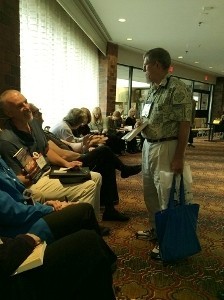
Bruce Coffin signing a book for John Clark. Dorothy Cannell and Kate Flora are at the far end of the signing line.

Panel on historical mysteries with James R. Benn, Mary Lawrence, Dorothy Cannell, Kathy Lynn Emerson and moderator Leslie Budewitz,
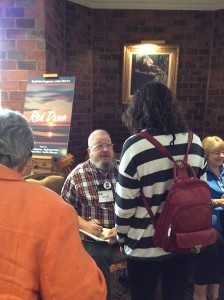
Kathy’s husband, Sandy Emerson, at his first signing for a story in RED DAWN.

Panel with authors of how-to books moderated by Hank Philippi Ryan. Shown are Elizabeth George, Paula Munier, Hallie Ephron and Kathy Lynn Emerson.
from Lea Wait: Today (Saturday, November 14,) I’ll be speaking about an author’s life and my LIVING AND WRITING ON THE COAST OF MAINE at Maine Coast Books, Maine Street in Damariscotta, Maine, at 11:00.
Then at the end of the week my books and I’ll be at Studio 53 (53 Townsend Avenue, Boothbay Harbor, Maine) along with wonderful local artists, writers and craftspeople for their annual Gifts for Giving show. The show will be open Thursday, November 19, from 11 am until 4 pm; Friday, November 20, from 11 am until 8 pm (including a Gala Reception from 5-8;) Saturday (early bird shopping in Boothbay Harbor) from 7 am until 4 pm; and Sunday the 22nd from 11 until 4.
An invitation to readers of this blog: Do you have news relating to Maine, Crime, or Writing? We’d love to hear from you. Just comment below to share.
And a reminder: If your library, school, or organization is looking for a speaker, we are often available to talk about the writing process, research, where we get our ideas, and other mysteries of the business. Contact Kate Flora: mailto: kateflora@gmail.com
November 12, 2015
Pups, Prison, and a Day in the Life
Jen Blood here, taking a break from informing the masses about the trials of indie publishing to tackle another subject very close to my heart. In September of this year, I got a rare but exciting opportunity to run with the big dogs, in the big house. Yes indeed… The Maine State Prison, in Warren. And before anyone gets up in arms about referring to the inmates as dogs, relax – I really mean dogs. Of the cuddly, furry, four-legged (or three-legged, in one case) variety.
At this point, prison programs that partner inmates with shelter dogs to assist with training before the pups are placed in forever homes are not really news. They’ve been around for decades, starting with a program spearheaded by Sister Mary Quinn in 1981. Since that time, these programs have gotten a lot of attention in the press for their ability to teach real-life skills while simultaneously promoting compassion and community mindedness in a prison setting. Since Quinn started the movement, a multitude of similar programs have sprung up around the country, with both inmates and prison staff citing shifts in inmate behavior, a decrease in tension among the prison population, and enhanced social skills between both the humans and the dogs onsite.

Logan, one of the pups in the K-9 Corrections Prison Program when I visited in September.
I’ve been aware of such programs for a while now, beginning when I first sat in on a training session with K-9 Corrections back in 2008. K-9 Corrections is a program operated through the Pope Memorial Humane Society of Knox County, pairing shelter dogs with inmates at the Maine State Prison in Warren. The program is run by dog trainer Marie Finnegan, who was mentoring me back in ’08 when I was finishing a dog training certificate program with Animal Behavior College.
Back then, the program was limited to one or two dogs who lived onsite at Bolduc Correctional Facility, the minimum-security prison just down the road from the Maine State Prison. Just over two years ago, Finnegan and K-9 Corrections were invited into MSP after being on a brief hiatus due to staff changes at Bolduc.
According to Finnegan, she’s been pleased to see how the program has developed since making the switch. “These guys really care about the dogs…and because they care about the dogs, they get to know the other trainers in the program… It’s a great way for everyone to relate to each other and start to communicate in a positive way.”
While I was excited to sit in on the session in 2008, it had very little in common with participating in the session at the Warren “Supermax” in September. There were forms to fill out, metal detectors to go through, pens and phones were surrendered, and then there was what felt like a very long walk down an echoing corridor with Finnegan and Case Worker Martha Boynton by my side. We ultimately ended up at a building that houses inmates under less restrictive guidelines than the neighboring buildings on the campus. I signed in at the central desk and waited as inmates began to file in. Not just inmates, though. Inmates with dogs.
The day I was there, there were five dogs and eleven trainers in attendance. The dogs ranged from pups like feisty Logan and the little three-legged spitfire Olive, to an aged Boston terrier named Charlie whose battle scars attest to the tough life she’s endured before being taken in by the Humane Society. A sweet but shy guy named Archer and the lovely Luna (papa and mama to Olive and seven other pups when they first came to HSKC) rounded out the program. I stood back while the guys ran the dogs through their paces, consistently impressed with how in tune the trainers were with their charges.
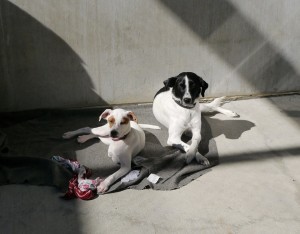
Olive and Archer — Archer is actually Olive’s dad. Here, I think you can definitely see a family resemblance.
When they come to the program, each dog is assigned a primary and secondary trainer. The dogs alternate between living and training with the primary and secondary trainers, which they do 24/7, sleeping in a crate in their cell, occasionally accompanying them to work or class, and then going out to exercise and work on training and socialization in the prison yard every day. Having a second trainer ensures that someone is always available if for any reason the other person on the team needs a break, works, or has an appointment where the dog isn’t able to come along.
Going through their paces, each training team that day would go up to the mat with their particular pup and demonstrate what they’d been working on for the week: sit, stay, down, come, and then a whole host of other tricks beyond the old standards, like twirl, moonwalk (you read that right), and wipe your paws (a tough one for Olive, who was born missing one of her front legs).
“People just take for granted that a dog can learn sit and stay,” says Finnegan, “even though some of those behaviors aren’t really that natural. But people assume a dog isn’t very smart unless he knows some tricks. Plus it’s good practice for the inmates to test their training chops.”
My favorite part of the afternoon comes when the training is done, however, and we’re able to go into the exercise yard. The yard looks much like a stereotypical prison yard you see in movies: concrete floor, concrete walls, a window too high up to reach, and a basketball hoop at one end. The dogs are able to go outside in the open air several times throughout the day, of course, but this yard is where the real fun is had, because it’s socialization time. Everyone is let off leash, and allowed to strut their stuff. Logan and Olive, the youngsters in the group, immediately race for one another and begin wrestling for all their worth. Archer, timid from the start, sticks close to his trainer, while Charlie — who hasn’t taken her eyes off her own trainer, Tom, since this session began — stays to the perimeter and Luna goes from person to person in search of treats and a little love.
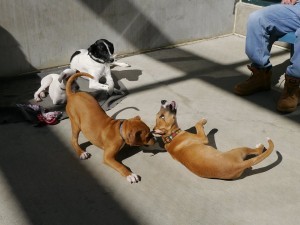
Playtime in the yard with Olive, Archer, Logan, and Bobby, a pup added to the mix after my visit.
In the yard, I ask the guys one of the more obvious questions I can think of: How hard is it to say goodbye when the training is done?
“That’s the hardest part,” Tracy, Luna’s primary trainer, says immediately.
“It’ll just about break your heart,” agrees Tony, Logan’s primary. “Especially if there’s a lot of time before you get the next dog. Then your room just seems way too empty.”
“Do you think the program has changed you?” Marie asks the guys as we’re wrapping things up.
There is unanimous agreement, with the guys citing things like increased engagement, more tolerance, having a reason to get up every morning.
“It gives you a sense of humanity,” Ron tells me then. The others quiet a bit. Ron is Archer’s trainer – he’s a big, quiet man whose insight when it comes to his charge has impressed me from the start. “When I came here, there wasn’t much that got through to me. I was shut down. Then I started doing this, and all of a sudden something clicked.” The others in the yard seem to agree. “Having somebody rely on you everyday, give you that kind of love and look to you for what they need… That makes a difference.”
As we say our goodbyes, the trainers thank me for my time. The dogs are tired, their tails wagging as they make their way through the doors and back inside. Other inmates greet the weary pups with smiles. This is a dark place in a multitude of ways – I know that. It’s unlikely that the men who are here got here by stealing pies from someone’s kitchen window, after all. But it makes me feel a little bit better about the universe as a whole, that we as a society are coming to realize that some of the things that truly make a difference in our behavior and ability to engage with one another aren’t punishment and isolation… Positive interaction, clear expectations, compassion and contact and, yes, puppy dog tails, all really do go a long way in this world.
To learn more about the K-9 Corrections program, visit them on Facebook at http://facebook.com/K9Corrections/. Special thanks to Marie Finnegan for providing the photos in this post.
November 11, 2015
The Light of Day
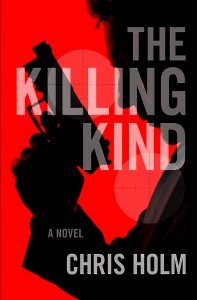 My god. November already. I confess, I’m not quite sure how that happened.
My god. November already. I confess, I’m not quite sure how that happened.
It’s been a month since last I posted here, and that month was an eventful one for me. THE KILLING KIND came out September 15. By October, it seemed as if the promotional cycle was winding down. Then, to my astonishment, Benjamin Percy of The New York Times Book Review weighed in with a doozy of a review. Here’s a taste of what he had to say:
As if that weren’t enough, the following week, The New York Times Book Review named THE KILLING KIND an Editor’s Choice. Nobody tell them, but I would’ve been delighted with an “Also out this month…” mention.
I’m grateful this book has struck a chord with readers, because there was a time when I wondered if it would ever see the light of day. In fact, come February 2013, I thought there was a chance my writing career was over.
I didn’t talk about it publicly at the time—in part because I’m not one to wallow in misfortune, and in part because I didn’t have the necessary perspective to do so without it coming off like sour grapes. But recently, the editor of The ITW’s The Thrill Begins, Ed Aymar, asked me if I’d share my story. He thought fellow authors might find it useful, and I agreed. You can read the piece I wrote for him here.
That piece was difficult for me to write, but I’m glad I did. Since it went live, I’ve spoken to loads of writers struggling through career setbacks and self-doubt who said it was exactly what they needed to hear. When I was down and out, my friends in the writing community helped pick me up and dust me off. The least I can do is try to pay that forward.
The fact is, I can’t guarantee your next project will be your breakout—but more importantly, you can’t guarantee it won’t… unless you never write it, that is.
All Those Years Ago
Bruce Robert Coffin here, taking a long look back . Several weeks ago, October 29th to be exact, my wife and I celebrated our thirtieth wedding anniversary. Thirty years! Why, it seems like only yesterday that the two of us met (almost 34 years ago). She a promising young cashier at a local supermarket (no longer there) and me an up and coming bagger of groceries. It was February and it was snowing. Our shift was nearing its end and the store was preparing to close (there were no twenty-four hour grocery stores back then). I was watching her walk outside to a row of shopping carriages, nestled up to the front wall of the building, right next to Bookland (also gone), when I made my move. She was looking plenty hot in her hunter orange cashier smock and name tag. I don’t recall exactly how I approached the subject of a date but I’m sure it was something suave and debonaire like: “Hey baby, what’s a nice girl like you doing in a place like this.” Anyway, whatever I said won her over because she said “yes.” And so we made a plan. Our first date was to be the night of the 15th. Yup that’s right, February 15th. Of course a smarter man would have shot for the 14th, Valentines Day, scoring a few points on the romantic front while simultaneously ensuring that if things worked out (and they have) I wouldn’t have to celebrate two days in February…
. Several weeks ago, October 29th to be exact, my wife and I celebrated our thirtieth wedding anniversary. Thirty years! Why, it seems like only yesterday that the two of us met (almost 34 years ago). She a promising young cashier at a local supermarket (no longer there) and me an up and coming bagger of groceries. It was February and it was snowing. Our shift was nearing its end and the store was preparing to close (there were no twenty-four hour grocery stores back then). I was watching her walk outside to a row of shopping carriages, nestled up to the front wall of the building, right next to Bookland (also gone), when I made my move. She was looking plenty hot in her hunter orange cashier smock and name tag. I don’t recall exactly how I approached the subject of a date but I’m sure it was something suave and debonaire like: “Hey baby, what’s a nice girl like you doing in a place like this.” Anyway, whatever I said won her over because she said “yes.” And so we made a plan. Our first date was to be the night of the 15th. Yup that’s right, February 15th. Of course a smarter man would have shot for the 14th, Valentines Day, scoring a few points on the romantic front while simultaneously ensuring that if things worked out (and they have) I wouldn’t have to celebrate two days in February…
The big night arrived. I picked her up at her house in South Portland. We were both dressed up and smiling, a lot. My stomach was in an absolute knot. We drove to The Jerry Lewis Theater (also gone, you might remember it as the more aptly named Maine Mall Cinema) where we attended a screening of the newest blockbuster, Indiana Jones, starring Harrison Ford. We shared some light hors d’oeuvres in the form of popcorn and soda, and I think this sly dog may have even slid an arm around her shoulders.
After the movie we drove to dinner, one parking lot over. I wanted her to experience the fine cuisine at the Maine Mall Pizza Hut (also gone). Yup, I know what you’re thinking, big spender. Hey, this guy knew how to live. To this day nothing beats the culinary delight of a pan pizza and an extra large Dr. Pepper. My wife tells a story of being horrified as she watched me swipe a piece of Pizza Hut silverware as a memento of our first date. Now, let me state unequivocally for the record that I have absolutely no recollection of said swiping. Hell, I went on to become a police officer, for crying out loud. She obviously has me confused with some other dashing young man she dated, with kleptomanical tendencies. Either way, since the statute of limitations on such a heinous crime has long since expired, if I had swiped said cutlery and given it to her as a first date keepsake, the fact that we are still together only speaks of her fondness for the “bad boys.” It would also have made her a co-conspirator and guilty of theft by receiving. Luckily nothing like the transgression for which I’m falsely accused actually took place. But I digress. Following a lovely dinner at Casa de Pizza, I drove her home where we “chatted” for a while before I bid her adieu. Promising to see her at work the following week.
Well, we’ve been seeing each other ever since. After a torrid three and a half year courtship (Hey, I never kiss and tell. You want details, wait for the book.), I asked for her hand in marriage. Again she said “yes.” Either I am extremely lucky or one sweet-talking son of a gun. Truthfully, I’m leaning toward lucky. We married in secret, on our only day off together, in the middle of the week, sneaking off to a JOP at a realtor’s office on Forest Avenue in Portland, next to the American Journal newspaper (Yup, you guessed it, both gone.) Our witnesses were two of the office staff, very nice ladies. I remember being so nervous they could have sold us a house and I wouldn’t have known it. We were dressed to the nines, her in a lovely flowered blouse and long dark skirt, me in tan slacks, button-down shirt with a tie, and my best navy blue polyester sport coat (The kind with the plastic buttons. Sharp.). We celebrated by dining at DiMillo’s Floating Restaurant, which, I’m happy to report, we didn’t put out of business (Steve, if you’re reading this, I swear to God there was no swiping of utensils). Afterward, we drove around visiting various relatives, informing them that we had gotten hitched.
Together we have travelled many miles since then, o’re hill and dale. We’ve shared the best and worse that life has to offer. Said goodbye to friends and loved-ones and welcomed new. We’ve struggled at times, prospered at others, but never have we quit. She is my best friend, my confidant, my lover, and my biggest fan. And I know she feels the same of me, because I am. This life is short, sometimes exhilarating, often hard, but it can be oh so sweet with the right companion, walking hand in hand beside you.
November 9, 2015
Six Lessons – Part One
By Brenda Buchanan
I’m writing this in early November, barely six months after launching my first novel, Quick Pivot, and a month after release of its sequel, Cover Story.
Amazingly enough, the third book in my Joe Gale Mystery Series, Truth Beat, already has been put to bed, as we say in the newspaper biz. Written, edited, proofed, gussied up with a beautiful cover to be revealed soon, Truth Beat is done.
Fini. Terminado. Críochnaithe.
Whew!
I’m now working on character sketches for my next book, one of my favorite parts of the process. I start with a few vague ideas about who will populate the story. I brainstorm names, backstories, genders, personalities, character flaws, then ruminate about these folks when not otherwise occupied. I dream about them, talk with them while driving (alone) and pretty soon I have a whole new community of imaginary friends with whom to share my life.
It occurred to me the other day that before I get too far along into the next book, it would be a good idea to take stock and share a few newfound insights. Here are the first three of six important lessons I have learned along the way. I’ll write about the other three in December.
Lesson #1: Make the Time. I could not have written three crime novels since 2008 if I didn’t write every day. At first, I didn’t appreciate the necessity of a routine. I thought I could only be productive if I had hours to sit down and immerse myself. I didn’t even try on days when I was busy, tired or uninspired.
It didn’t take long for me to realize this approach was unworkable. I have a rather demanding day job and numerous family and other commitments. If I didn’t make time to write, it wouldn’t happen. Creating a regular rhythm required me to transform the way I thought about my writing. Instead of it being something I might do after work, I decided to make it something I would do, no matter what kind of day I’d had and no matter what else was competing for my attention.
At first it felt rather grim, like rejoining the gym after a long absence, when your muscles ache after ten minutes on the Stairmaster and the acerbic voice in your head razzes you about how stupid it is to spend your time climbing imaginary stairs. Why are you wasting your energy? You don’t have time for this foolishness.
But I stuck with it. As with the gym, once I found my writing groove, I began to feel out of sorts if my routine was interrupted. It wasn’t always fun to park myself in front of the computer, but as time went on it felt good, in an odd sort of way.
Linear gal that I am, I started at the beginning and moved toward the end at a clip of two pages a night. I only deviated from this method when I found myself writing in circles or stepping on my own clues, which necessitated going backward only enough to get myself back on track. This dutiful approach resulted in a complete first draft, which at the time felt like more than half the battle. (It wasn’t, but the beauty of revision is a lesson for next month.)
I know that other writers take different approaches. Some write the last chapter first, or write in scenes, not chapters. I don’t think it matters how one goes about writing the book so long as there’s a regular routine to keep you engaged with the process, day in and day out.
Lesson #2: Create The Space. My decision to commit to my writing happened shortly after I moved from Peaks Island to the mainland. I put a desk in the part of our finished basement that the prior owners had used as an office and christened it Brenda’s Writing Cave. I stuck it out for maybe six months before realizing a subterranean space where I felt completely cut off from what was happening in the outside world was not for me.
Going to the other extreme, I set up shop in the den, which had the opposite drawback—it was in the middle of everything. Too close to the fridge and the TV, with a perfect view of the birdfeeders where something fascinating always was happening. So I moved my writing spot upstairs, which has proved to be the charm.
I am sitting in my “study” right now, which doubles as our guest room. It is quiet, especially in the cold weather months when the windows are closed. I have a bookcase for my stuff, and a beautiful photograph of the islands of Casco Bay above my desk.

The photo of Casco Bay that hangs above my desk. Beautiful, and less distracting than a window.
I work here most of the time, though sometimes avail myself of the Sunday morning solitude of my unoccupied law office or seek out a quiet nook at one of several local libraries. No matter where I sit, water is at hand, occasionally coffee or tea. There are both pencils and pens within easy reach, and for reasons I can’t explain, a tube of lip balm is essential.

My desk, with pencils at the ready. The mugs feature my book covers, a gift from my thoughtful sister-in-law Chris Kenty.
I don’t snack while I write, or attempt to write with my laptop balanced on my knees. I need a desk or table and a reasonably comfortable chair.
I get down to business without detouring past email or social media. Like a diver swinging her arms before climbing the tall platform, I re-read the pages I wrote the previous day to warm my writerly muscles. Then I plunge in, and stay there until I’ve met my word goal for the day.
Having a comfortable, dedicated space to create maximizes the chance of uninterrupted work, and fewer interruptions mean greater productivity.
Lesson #3: Treasure those who love you.
No one does this alone. I knew that going in, but now I really know that.
While I’ve been busy writing, my spouse has managed our life. I still cook, but she does most everything else. Laundry. Cleaning. Gardening. Social calendar management. She helps me with writing-related tasks (like managing my mailing list) and is my first reader and the giver of much helpful feedback. She also sits in the front row at all of my speaking gigs.
This kind of active support is precious. As important—perhaps even more so—are her regular reminders to unplug from the intensity. We have a Sunday beach walk routine, no matter what the weather. We’re working our way through the eight seasons of Foyle’s War (how did we miss them when they were first aired?), and we swim every chance we get in the warm weather months. This counterweight to my every-day-I-must-write obsession is critical to my mental health.
I also am lucky to have a supportive group of friends, who I don’t see enough. We all have a lot going on in our lives, but for the past couple of years, I’ve too often been the one turning aside invitations, claiming not to have time to meet for dinner or go for a walk. Righting that particular imbalance is my goal for this winter, because life is too short to spend all my time with my imaginary friends when I am blessed with so many wonderful real ones.
Balance. It’s all about balance. How do you try to achieve that complex equilibrium? I am interested in your thoughts.
Stay tuned next month for lessons 4 through 6.
Want to get your book published? Start with a Crimebake
Hi all, Maureen here.
Sorry this is a little late this morning. Must still be recovering from this year’s excellent New England Crime Bake.
Some of you may be asking, “So, what’s a Crime Bake?” Eight years ago, I would have asked the same thing.

A Saturday morning panel at this year’s Crime Bake talks about the secrets to success. From left, Hallie Ephron, this year’s special guest Elizabeth George, Gayle Lynds, Peter Abrahams and moderator Ray Daniel, president of Mystery Writers of America, New England Chapter.
Back in 2008, I’d been intending for years to get a start on writing my first mystery novel. As many of you who have been in that position know, getting started can be the hardest part. I had a lot of “reasons” to stall, none of them very good. I knew that even then. But a big and very real issue — probably the biggest — was that I was in a total vacuum and had no idea really where to begin, how to get guidance along the way and what to do once it was done.
Since I didn’t know anyone who could help me with any of that, I decided to find people who could. That led me to the Mystery Writers of America, and through my googling and other research of that, led to my first Crime Bake, a weekend-long conference sponsored by the MWA New England Chapter and Sisters in Crime New England. I knew I desperately needed to go. I have never regretted that decision and haven’t missed one since. It is, seriously, my favorite weekend of the year.
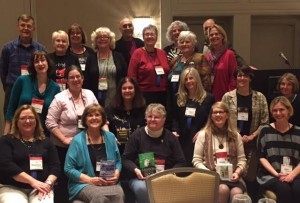
The 22 debut mystery novelists recognized at this year’s Crime Bake included me (Maureen Milliken) and fellow Maine Crime Writer blogger Brenda Buchanan.
That first year, I walked in Saturday morning (had to work Friday night) and found 250 people, many of whom were writing, wanted to write, or had written mystery novels. It was like an orphan finding the lost family she never knew she had. Not only was the sense of community more empowering that I ever could have predicted, but just knowing there were other people like me — and people successfully doing this! — was a huge step in getting me going, finally, on my own mystery novel.
I vowed at that Crime Bake to return to the next one with a finished manuscript I could pitch to an agent.
And now, here I was this weekend, eight Crime Bakes later, finally with a published book. I was one of 22 debut novelists at the event recognized this year. It was probably one of the highlights of my adult life. Or life, actually.
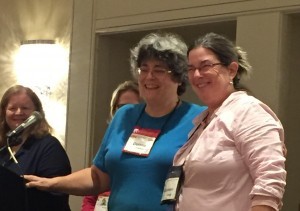
Mystery Writers of America Executive Vice President Donna Andrews presents me with a ribbon recognizing me as one of the 22 debut novelists at the 2015 New England Crime Bake.
It wasn’t a smooth road from that 2008 Crime Bake to being a published novelist at the 2015 event. A lot of factors, a lot lot lot of factors, went into finally getting that manuscript — which was just a few thousand words, jumbled ideas and going nowhere in 2008 — published. But I never, ever would have gotten where I am today if it weren’t for Crime Bake.
The advice (biggest takeway ALWAYS is to not give up), the guidelines for being professional and taken seriously, and the generous, supportive community are the foundation that I’ve built my mystery novelist career on.
I can’t stress enough to aspiring writers that the first step to getting unstuck and getting going is to find a Crime Bake and go to it. I highly recommend this one, even for people
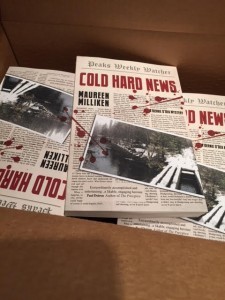
Look what I’ve got! Finally, at my 8th Crime Bake, I can say I’m a published author. And it feels pretty damn good.
who write in different genres, but there are conferences like it, big and small, all over the country all the time. Find the money and the time, go to it and learn.
And never look back. Thanks Crime Bake!
Maureen Milliken is the author of Cold Hard News, the first in the Bernie O’Dea mystery series. Follow her on twitter at @mmilliken47, on Facebook at Maureen Milliken Mysteries, and check our her website, maureenmilliken.com.
November 6, 2015
Weekend Update: November 7-8, 2015
 Next week at Maine Crime Writers there will be posts by Maureen Milliken (Monday), Brenda Buchanan (Tuesday), Bruce Coffin (Wednesday), Chris Holm (Thursday) and Jen Blood (Friday).
Next week at Maine Crime Writers there will be posts by Maureen Milliken (Monday), Brenda Buchanan (Tuesday), Bruce Coffin (Wednesday), Chris Holm (Thursday) and Jen Blood (Friday).
In the news department, here’s what’s happening with some of us who blog regularly at Maine Crime Writers:
from Kathy Lynn Emerson: There’s still time to win a copy of Murder in the Merchant’s Hall at Goodreads. The giveaway runs until November 9. Here’s the link: https://www.goodreads.com/book/show/26265846-murder-in-the-merchant-s-hall
from Kaitlyn Dunnett: The first book in the Liss MacCrimmon series is on sale in e-format during the month of November. It’s marked down to $1.99 for your Kindle, Nook, or iPad. Kensington Books, the publisher, is also reducing prices on other cozy mysteries in the near future, including some by fellow bloggers Barb and Lea.
This weekend, November 6-8, most of us (all of us??) will be at Crime Bake, a mystery convention in Dedham, Massachusetts, co-sponsored by Sisters in Crime of New England and Mystery Writers of America (New England).
An invitation to readers of this blog: Do you have news relating to Maine, Crime, or Writing? We’d love to hear from you. Just comment below to share.
And a reminder: If your library, school, or organization is looking for a speaker, we are often available to talk about the writing process, research, where we get our ideas, and other mysteries of the business. Contact Kate Flora: mailto: kateflora@gmail.com
November 5, 2015
Cats, Dogs, and Dastardly Deeds
Kaitlyn Dunnett here, hawking my new Liss MacCrimmon mystery, The Scottie Barked at Midnight, which has been out in hardcover and ebook formats for a whole week and a half now. In some ways, it was a challenge to write this one.
Dilemma: how to add dogs to a series that already has two cats.
Solution: keep them (mostly) separated.
In The Scottie Barked at Midnight, on a cold and bleak March evening, Liss MacCrimmon is driving home from a shopping spree at the outlets in Freeport, Maine when something darts in front of her car. Afraid that she’s hit a dog or a cat, she stops to look for the animal. What she finds, mercifully uninjured, is a lost and shivering Scottish terrier. She takes the little dog, a female, to the nearest vet and then agrees to keep her until the owner is found.
She did not consult her two cats, Lumpkin and Glenora. Needless to say, neither is thrilled to have a house guest. Fortunately, the Scottie, Dandy by name, is soon claimed. Not so fortunately, Dandy was running loose because she was dognapped, and returning her to her owner leads to Liss’s involvement in yet another murder.
Lumpkin and Glenora were on the cover of an earlier adventure, Scotched. For The Scottie Barked at Midnight, it is Dandy in the cover illustration. In fact, there are two Scotties in the story, Dandy and Dondi, two-thirds of an act called “Deidre and her Dancing Doggies” that is primed to win the top prize on a television variety show . . . until someone does in Deidre.
In need of another dancer to fill in for the murdered woman, Deidre’s daughter taps Liss. She was once a professional Scottish dancer, after all. How hard can it be for her to learn the steps to accompany two trained pups? In fact, it isn’t hard at all. The hard part is figuring out who killed Deidre and who is behind the dirty tricks haunting the competition, before that unscrupulous person can knock Liss out of the running, too.
Kaitlyn Dunnett/ Kathy Lynn Emerson is the author of over fifty books written under several names. She won the Agatha Award in 2008 for best mystery nonfiction for How to Write Killer Historical Mysteries and was an Agatha Award finalist in 2014 in the best mystery short story category for “The Blessing Witch.” Currently she writes the contemporary Liss MacCrimmon Mysteries (The Scottie Barked at Midnight) as Kaitlyn and the historical Mistress Jaffrey Mysteries as Kathy (Murder in the Merchant’s Hall). The latter series is a spin-off from her earlier “Face Down” series and is set in Elizabethan England. Her websites are www.KaitlynDunnett.com and www.KathyLynnEmerson.com


